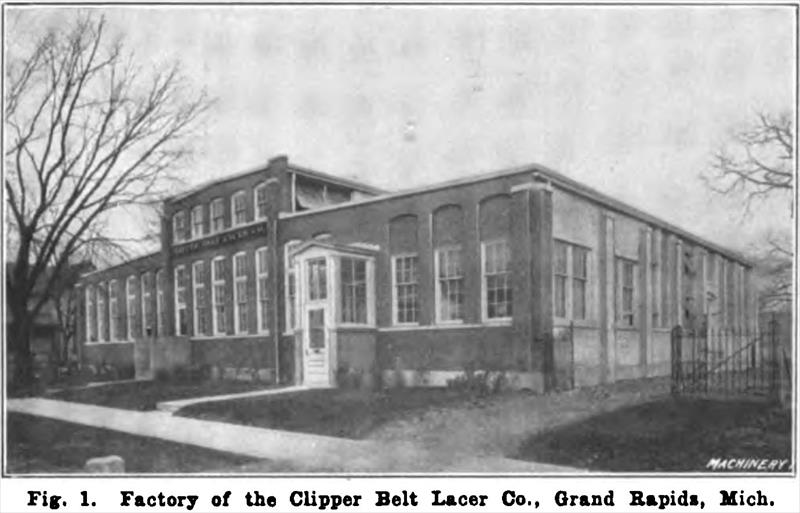 |
| From November 1913 Machinery |
Before 1900 belt lacing was typically performed using a needle and stout thread. The multi-step process required a fair degree of skill. At some point someone ("Webb"? This is a subject of further research) had the idea of using metal clips to hold together the belt ends. These early systems had some shortcomings, such as the fact that they used staples that were all the same size, leading to holes in the belt ends that are in a straight line, which could lead to tearing of the belt. And a lot of steps and hand labor was still required.
In 1905 a couple of Englishmen, Frederick Mitchell and Francis Gunn, patented a device for jointing belt ends. Their system used a series of D-shaped staples (clips) that were inserted individually but then crimped all at once on the end of a belt, creating a series of metal loops sticking out from the end of the belt. The same thing was done on the other end of the belt, and then a pin was passed through the loops to hold the belt ends together. At that time there was an American in London, one James Barns Stone, who found out about this new belt lacing device, came up with some minor improvements, and obtained his own patent. He moved back to Grand Rapids, Mich., and established the J. B. Stone Co. to manufacture his belt lacer. His "Clipper" belt lacer was introduced by J. B. Stone Co. in about 1910.
There followed a rapid series of improvements to the Clipper system. James K. Diamond applied some basic mechanical engineering principles to improve and simplify the mechanism. Joseph C. Conn came up with the key idea of joining the clips together (which he did by forming the clips from a continuous piece of wire; an additional operation was required to cut the clips apart after they were inserted into the lacer but before being inserted into the belt end) and staggering the ends of the clips to reduce the chances of the belt tearing. And then Diamond came up with a really key improvement, which was to have separate clips joined by a strip of paper that held them in position, ready to be inserted into the holes and crimped. Diamond incorporated Conn's idea of staggering the clip ends.
In 1913 the J. B. Stone Co. was renamed to the Clipper Belt Lacer Co.. The company was refinanced with a larger capitalization, which suggests that they were growing rapidly. Various imitators appeared but Clipper continued to patent new improvements to their lacers, which they made in a wide variety of models, including both stationary and handheld models.
In 1995, Clipper Belt Lacer Co. was bought by Flexco Co., Downers Grove, IL, and became a division of that firm. Flexco had originally been known as Flexible Steel Lacing Co. Clipper for some years continued doing business under their old name, until 2008 when they became Flexco Grand Rapids.
Information Sources
- 1911-03-07 writeup on J. B. Stone Co.'s Clipper belt lacer, in Power magazine.
- May 1912 Mill Supplies. "J. B. Stone Company, Grand Rapids, Mich., has let the contract for a factory, to be of brick and cement, one story high, 75x100 feet."
- June 1912 Mill Supplies. "The J. B. Stone Company, Grand Rapids, Mich., manufacturers of a belt lacing appliance and other mechanical specialties, has increased its capitalization from $25,000 to $45,000."
- April 1913 ad in Mill Equipment.
- 1918 book, Grand Rapids and # County, Michigan.
- 2008 Blog post announcing name change rom Clipper Belt Lacing Co. to Flexco Grand Rapids. The parent company is Flexco.